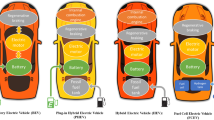Abstract
Stringent regulations on exhaust emissions and fuel economy for vehicles have become major issues in the automotive industry. Hybrid electric vehicles (HEV) are one of the crucial alternative plans to current conventional vehicles, but they have drawbacks, which include increases in total hydrocarbon (THC) emission from the engine and deterioration of the combustion stability with frequent stopping and restarting of the engine. Intake port fuel film is evaporated up during the deceleration state due to the fuel-cut. The λ (relative A/F ratio) at engine restart is lean because part of injected fuel is used to form the fuel film in the intake port. This study revealed the behavior of a fuel film in engine stop with fuel-cut and in engine restart with a simulation model. To investigate the fuel film characteristics, a simulation model was applied and validated with a single-cylinder engine. The simulation result shows that λ of at least 1.2 is required for a stable engine restart. The minimum injection quantity of the first cycle for stable combustion is suggested to be at least 240% of the steady-state idle condition.
Similar content being viewed by others
References
Almkvist, G., Denbratt, I., Josefsson, G. and Magnusson, I. (1995). Measurement of fuel film thickness in the inlet port of an SI engine by laser induced fluorescence. SAE Paper No. 952483.
Bauer, W., Balun, P. and Heywood, J. (1997). Heat transfer and mixture vaporization in intake port of sparkignition engine. SAE Paper No. 972983.
Bishop, J., Nedungadi, A., Ostrowski, G. and Surampudi, B. (2007). An engine start/stop system for improved fuel economy. SAE Paper No. 2007-01-1777.
Chen, K. (1994). Fuel Volatility Modelling. M.S. Thesis. MIT. USA.
Cho, H. (2002). Investigation of Liquid Fuel Film Behavior in Spark Ignition Engines. Ph. D. Dissertation. Seoul National University. Seoul. Korea.
Cho, H., Kim, M. and Min, K. (2001). The effect of liquid fuel on the cylinder liner on engine-out hydrocarbon emissions in SI engines. SAE Paper No. 2001-01-3489.
Duoba, M., Bohn, T. and Lohse-Busch, H. (2005). Investigating possible fuel economy bias due to regenerative braking in testing HEVs on 2WD and 4WD chassis dynamometers. SAE Paper No. 2005-01-0685.
Frottier, V., Heywood, J. and Hochgreb, S. (1996). Measurement of gasoline absorption into engine lubricating oil. SAE Paper No. 961229.
Guillemin, F., Grondin, O., Chauvin, J. and Nguyen, E. (2008). Combustion parameters estimation based on knock sensor for control purpose using dedicated signal processing platform. SAE Paper No. 2008-01-0790.
Heywood, J. B. (1988). Internal Combustion Engine Fundamentals. McGraw-Hill. USA.
Hu, X., Wang, Z. and Liao, L. (2004). Multi-objective optimization of HEV fuel economy and emissions using evolutionary computation. SAE Paper No. 2000-01-1543.
Huang, Y. J., Yin, C. L. and Zhang, J. W. (2009). Design of an energy management strategy for parallel hybrid electric vehicles using a logic threshold and instantaneous optimization method. Int. J. Automotive Technology 10,4, 513–521.
Hwang, S. H. (2001). Investigation of Port Injected Fuel Transport Behavior in a Spark Ignition Engine. Ph. D. Dissertation. Ajou University. Korea.
Johnson, V. H., Wipke, K. B. and Rausen, D. J. (2000). HEV control strategy for real-time optimization of fuel economy and emissions. SAE Paper No. 2000-01-1543.
Klein, D. and Cheng, W. K. (2002). Spark ignition engine hydrocarbon emissions behaviors in stopping and restarting. SAE Paper No. 2002-01-2804.
Lang, K. and Cheng, W. (2006). Effects of fuel injection strategy on HC emissions in a port-fuel-injection engine during fast idle. SAE Paper No. 2006-01-3400.
Linna, J. R., Malberg, H., Bennett, P. J., Palmer, P. J., Tian, T. and Cheng, W. K. (1998). Combustion of oil layer mechanism to the hydrocarbon emissions from sparkignition engines. SAE Paper No. 982645.
Nagaoka, M., Ohsawa, K., Crary, B., Yamada, T., Sugiura, S. and Imatake, N. (1997). Numerical analysis of fuel behavior in a port-injection gasoline engine. SAE Paper No. 970878.
Ng, H. K., Anderson, J. A., Duoba, M. J. and Larsen, R. (2001). Engine start characteristics of two hybrid electric vehicles (HEVs)-Honda Insight and Toyota Prius. SAE Paper No. 2001-01-2492.
Pierre, P., Castagne, M., Corde, G., Eyssavel, G. and Floch, A. (2004). Analysis of HC emissions on single cylinder during transient conditions. SAE Paper No. 2004-01-0981.
Saito, K., Sekiguchi, K., Imatake, N., Takeda, K. and Yaegashi, T. (1995). A new method to analyze fuel behavior in a spark ignition engine. SAE Paper No. 950044.
Sambuichi, H. and Taniguchi, M. (2005). Investigation of the potential problems caused by idling stop assist system. SAE Paper No. 2005-08-0380.
Shiao, Y. and Jow, M. (2007). Analysis of hybrid electric vehicle performance-an HEV test in the urban area. SAE Paper No. 2007-01-0289.
Shin, Y., Cheng, W. K. and Heywood, J. B. (1994). Liquid gasoline behavior in the engine cylinder of a SI engine. SAE Paper No. 941872.
Taniguchi, M. and Sato, F. (2003). The effect of idling stop at red light for fuel saving from the data of the field test. SAE Paper No. 2003-08-0016.
Xuan, D., Kim, J. and Kim, Y. (2011). Optimal operation strategy development for fuel cell hybrid vehicle. J. Mechanical Science and Technology, 25, 183–192.
Author information
Authors and Affiliations
Corresponding author
Rights and permissions
About this article
Cite this article
Yu, S.E., Ohn, H.S. & Min, K.D. Investigation of engine restart stability after idle stop for a mild type HEV powertrain. Int.J Automot. Technol. 14, 683–692 (2013). https://doi.org/10.1007/s12239-013-0074-3
Received:
Accepted:
Published:
Issue Date:
DOI: https://doi.org/10.1007/s12239-013-0074-3




